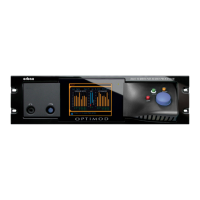OPTIMOD SURROUND PROCESSOR INTRODUCTION
1-5
• OPTIMOD 8685’s inputs and outputs are highly configurable via remote-
controllable internal routing switchers. Additionally, the outputs of the
multichannel and 2.0 processing chains can be independently configured to emit
the output of the AGC or the output of the multiband compressor/limiter,
all configurable to use or bypass look-ahead limiting.
• Via the internal output routing switcher, a given output signal can be applied to
more than one hardware output. This allows using the 8685 as an AES splitter.
• For both the base I/O configuration and the optional HD-SDI module, a stereo
analog monitor output appears on XLR connectors on the rear panel. It can be
configured to emit any 8685 output signal, including a downmix of the mul-
tichannel audio. The analog outputs are transformerless, balanced, and floating
(with 50Ω impedance) to ensure highest transparency and accurate pulse re-
sponse. They can be used to drive a transmitter, although their normal function
is monitoring.
• A stereo headphone jack is available on the front panel. It can be configured
to emit any 8685 output signal and is independent of the stereo analog monitor
output.
• Two RS485 serial ports allow the 8685 to accept and emit Dolby Digital
metadata. If the optional HD-SDI module is installed, metadata can also be de-
embedded and re-embedded in the HD-SDI VANC area and, if the Dolby-E
modules are installed, de-embedded from and re-embedded into Dolby-E data
that is conveyed either through from the HD-SDI connection or the AES3id con-
nections.
• The 8685’s 2.0 processing offers a dual-mono mode that allows two entirely
separate mono programs to be processed, facilitating multiple-language opera-
tion.
In this mode, both processing channels operate using the same process-
ing parameters (like release time); you cannot adjust the two channels to
provide different processing textures.
• An audio sync input is configurable to accept AES11id or wordclock sync.
You can synchronize the output sample rate of all AES3id outputs to this input.
You can also synchronize the outputs to the AES3 digital input #1 or to
the 8685’s internal clock. The sync source of each AES3 output is independ-
ently selectable.
• In the optional HD-SDI module, a BNC connector can accept video sync per
SMPTE 274M and SMPTE 296M, which can be used as a reference for the out-
put audio sample rate and to correctly align Dolby-E frames with video per
Dolby's requirements. The signal applied to the SDI input can also be used as a
sync reference.

